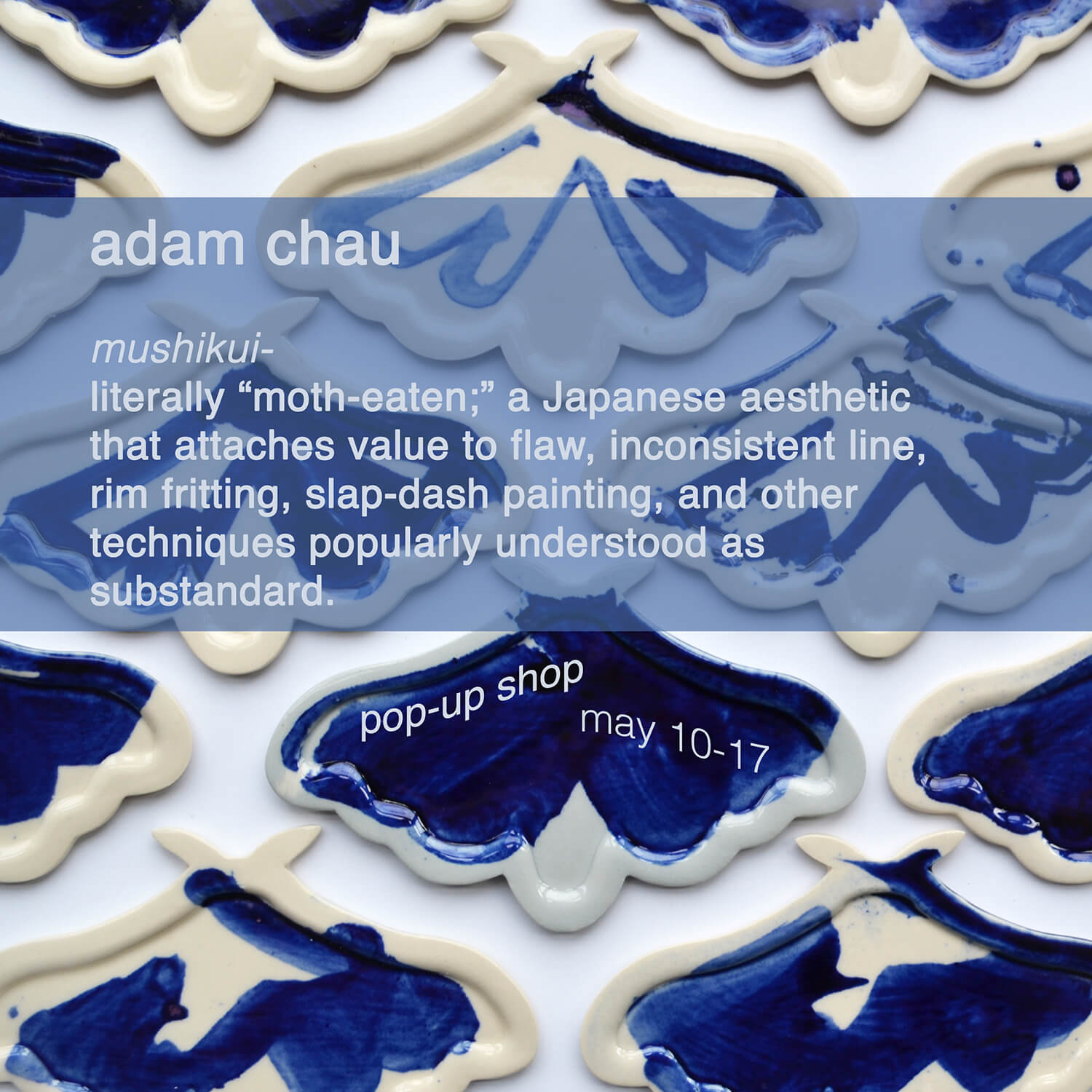Our pop-up shop resident for the month of May is Adam Chau, whose work explores how we can introduce the human hand into computer-controlled environments. He makes handmade brushes that replace standard bits on a CNC machine to surface ceramic objects in cobalt blue. By having a unique tool only made possible by the hand, the outcomes differ from each other even when the program is repeated.
The moth silhouette of these plates is a reference to the term ‘mushikui’ (moth-eaten edge), which describes a favorable, inconsistent cobalt line in porcelain decoration. Silhouetted animal and body part shapes mimick ko-sometsuke ware (Chinese exports of silhouetted dishes for the Japanese market) to show that digital technology can develop while still holding on to traditional themes. Adam Chau currently lives in Port Chester, NY where he is a Program Manager at Clay Art Center.
I had the opportunity to ask Chau some questions about his work and his process. Check it out below, then head over to the shop to get one of his peculiar plates before they all sell out!
Cfile: Tell us about CNC technology. How did you get involved with using CNC in your ceramic work?
Adam Chau: CNC technology is an umbrella term that encompasses everything that uses numeric code to control a machine from a 3d printer to a 2d inkjet printer. In essence it does exactly what we tell it to do very precisely, so it takes creativity and innovation to push it to its limits much like how a potter’s wheel is useless until human hands interact with it. The machine I currently use is a milling machine where I turn the spindle off – I’ve converted it into a surfacing machine; handmade brushes go on and the program that I upload tells it where to go.
I’ve always been fascinated with multiples – I’m the son of a baker and production has always been a part of my life. After getting a foundation of ceramics in the traditional sense I found that I was craving information on contemporary manufacturing processes so I went to graduate school for industrial design (the Designed Objects program at the School of the Art Institute of Chicago). When I was there I was pushed to explore digital manufacturing as one of the main processes for production – I became weary of the methodology because everything was so regular and had clean lines – I decided there that I would dedicate my time to find ways to alter, expand, and hack these machines to accept spontaneity and irregularity.
You have said you are “interested in the term ‘mushikui’ (moth-eaten edge), which describes a favorable inconsistent cobalt line in porcelain decoration, and how this can translate into digital manufacturing.” What does this mean… exactly how does mushikui translate into digital manufacturing?
I’m really interested in creating unique surfaces with technology. Instead of having “perfect” lines I wanted gestural and inconsistent ones; I found a relationship with mushikui because it was a term that gave accolades to irregularity. I thought it was a perfect fit to marry mushikui with the process that I use, hence why the plates are moth shaped. To me, having historic reference adds to the conversation because I believe this makes a case that ceramic processes are a continuum and evolution, not a harsh line that steps from one method to the next – just look at the conversion from foot-powered wheels to electric ones.
Adam Chau, Pie-molded moth plate with gold luster, 2017, porcelain, cobalt, gold luster
Mushikui originally referred to the inconsistent line on blue and white painted porcelain in China. This must be why you chose cobalt for the decorative color?
Exactly. I use cobalt for two reasons: one is that it has a historic reference, but the second (and more important) is that cobalt out of all the other oxides is the most sensitive to overlapping and movement; it gives a fantastic sense of depth that I haven’t found in other oxides. Also, you can identify a pinpoint change of direction, which I need because really what I’m after is a record of movement.
Interesting. And there’s more than just moths! I saw some bunny-shaped plates at NCECA (I think they were bunnies!). What are they referencing ? What other shapes have you executed?
The bunnies were actually two hands side by side (think if you put your hands out with your pinkies together).
I think that the silhouetted plate is a good format for me since the cobalt brushstroke can be so abstract sometimes it needs a border to make it visually legible. Another historic reference, this is harps to Ko-Sometsuke, where mushikui comes from. I’ve made faces, palms, and geometric shapes and love it all. Lately I’ve been thinking of what a “contemporary digital silhouette” would be and have some ideas on the horizon.
How do you imagine pottery-making will change in the future?
I hope that digital technology becomes a tool for potters use just like any other machine in the studio. I don’t think that there should be such a novelty for it. I think that technology can be useful for prototyping or mold making and hope that people use it as a resource. I also see a blending of art/craft/design and think that there have been some very big steps in knocking down walls – designers are getting dirty and potters are getting high-tech – I love it!
How do you imagine these plates being used and/or displayed?
These plates are small and intimate – I have them both on my wall where they look like they’re pinned specimens (I use a plate hanger) and on my bedside for jewelry and coins.
Why put gold luster on two of them?
That’s a secret
Hahahaa. Well, thanks Adam! Good luck with the shop.
Thanks!







Add your valued opinion to this post.